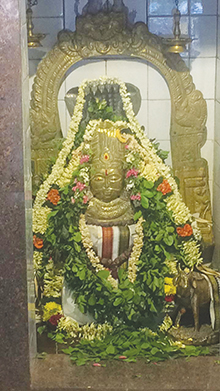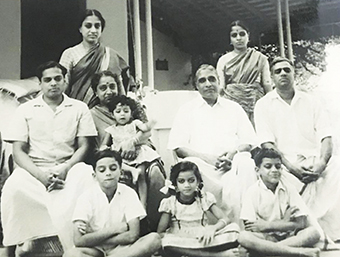Indians have been grazers and farmers from time immemorial. The people of the Kongu region specialized in cattle rearing. The herders led a nomadic life. They lived in settlements called ‘Pattis’ along with their cattle. Indian people lived in villages, city clusters, in the forests and also as nomadic cattle grazers. It was a diverse and complete country. The wealth of a person was measured based on the heads of cattle owned by him or her. Ancient epics like Mahabharata talk about the cattle wealth of the land and the stories associated with the same. The lands of the Kongu country are little hardy and therefore one had to toil a bit more in order to get the desired results. Therefore the farmers reared cattle in order to supplement their income. The black cotton soil, red soil and the soil which nurtured forests were found side by side in the Coimbatore region. No wonder the soil diversity created a diverse agrarian culture. Farmers, herders and the tribal people lived in close proximity of each other. Of course the wild animals found the nearby western ghats kept them close company. The River Noyyal jumped out of the wilds and added wealth to the populace. Spices, forest produce, garments and jewellery were once exported to Rome and the people earned in gold and silver. A number of kingdoms and empires conquered the region. It was like a musical chair of sorts. However the herders continued to grow in number and added to the production of milk and dung. The huge quantities of dung and urine from the cattle helped them to farm successfully. Natural manure enriched the land and its people.
The people learnt the art of not just rearing cattle but also taking care of their health issues. A number of veterinary experts straddled the land. If the doctors could not solve the issues people turned to God. The Lord on the banks of the River Noyyal at Perur, Patteswarar is considered to be the deity of these farmers and cattle grazers who formed part of the land. They used to celebrate their animals by taking good care of them. The animals which fed and enriched the society were deified. No wonder one can get to see a cow with a big udder (emblazoned in silver) behind Lord Patteswarar at the Perur temple. The cow became a sacred animal for it was a one stop provider. It gave milk which nourished the human, dung and urine which added to the fertility of the land. Indians were ever known to revere nature and they naturally revered the cow.
The countrymen celebrated ‘Maattu Pongal’ with full gusto year after year. Cows used to be painted, caparisoned and taken on a procession on the Pongal day. Women used to apply turmeric and kumkumam to the cow on Fridays and offer prayers. This was known as Gopooja and it was considered to confer plenty. Going around a cow while it delivered a calf was considered to be like going around the whole world. The cow was immortalized in the movie ‘Saraswathi Sabatham’ through the song Gomatha Engalkulamatha’.
The people of Coimbatore used to take their cows and bulls to the ‘Madheswaran Temple’ on Thadagam Road on successive Maattu Pongals over centuries. This simple looking temple is endowed with a utilitarian tiled roof. Icons of Lord Ganesha and Lord Shiva are placed under a tree. The small and nice sanctum is the home to Lord Madheswara, who is considered to be the Lord of the cows. Devotees offer prayers in this temple in order to seek a cure for the ailments which made their cattle suffer. There was a time when 1500 plus cows, bulls and calves used to be brought in a procession to this temple and people used to throng the road in order to catch a glimpse of the celebrations. Rapid urbanization has reduced the number of cows within the city and just 150 animals come here on Maattu Pongal these days !
The legend states that this deity is named after Lord Madheswara in Madheswara Hill (Chamrajnagar, Karnataka). Whenever cows fell ill or refused to give milk people used to take the cows to a Saint in the hill temple for they believed they will be cured. It was in the same belief that this temple was established. The temple is about 300 years old and it is said that the Hindu soldiers of Tipu Sultan established the temple for worship. However there are many who state that the temple must have been established 300 years ago for the rulers of Mysore had been governing Coimbatore from the seventeenth century. The practice of donating animals like cows to the temple have been part of our culture. Taking cattle to a temple was kind of a thanksgiving. A temple was considered to be full fledged if it had cows in its premises.
Lord Madheswaran is offered all kinds of worship and alankarams. However the Raja Alankaram is famous here. All the routine festivals connected with temples associated with Lord Shiva are celebrated here. Lord Madheswara is considered to be the guardian of the livestock in this part of the country. A number of big farmers in Vedapatti, Sundapalayam, Ondipudur, Vellakinaru, Thudiyalur, Singanallur used to bring their cows here on Maattu Pongal. B.Rangaswamy Naidu of Rajalakshmi Mills was among the largest urban owner of milch animals, for he used to own 1800 cows and bulls at one point of time. His farm used to have the best stock of good quality ploughshares. Industrialists R.Venkataswamy Naidu, G.R.Govindarajulu and others had some of the best looking cows in Coimbatore. Sugantha Devaraj of Race Course, known for her green thumb used to have a number of cows in Race Course until recently. She continues to look after her apartment building with utmost care and she is a role model for many.
The Indians venerated farming and the ploughshare was the accompaniment of Lord Balarama, the elder brother of Lord Krishna – the cowherd deity who is also known as Govardhanagiridhari. On visiting the places associated with cows, grazers and their deities we can understand that India was full of them. Lord Shiva is also known as Pasupathi (Lord of the animals).
The Pattakarar of Palayakottai will ever be remembered for the ‘Kangayam Kalai’. The Zamindar of Samathur (near Pollachi) Ramaraj Vanavarayar had the best rekhla bulls and carts in this part of the country and they used to win a number of rekla races for a long time. The bulls belonging to the Samathur Zamin were very well looked after and they had the best sheen. Arunkumar Kalingarayar of the Uthukuli Zamin family had a huge dairy farm which had about 50 in their old family residence at Race Course. The cows were revered and taken care of by both, the prince and the peasant. The love for cattle was universal.
The cow belonging to the residence of Jeweller P.A.Raju Chettiar used to be decorated with a huge quantity of jewels every Maattu Pongal and brought to the Madheswaran temple. Thousands of people used to wait in order to see this veritable Gomatha. The hump used to be decorated with odiyanams, the horns with necklets, bangles and chains. The body used to be covered with long chains. Kilograms of gold used to shine of the wonderful looking cow which was known as Gomatha. The visitors to the temple used to offer prayers to this cow of plenty. Lord Madheswara who continues to live in simple tiled roof temple continues to offer a lot of prosperity to the Coimbatore region.
—Rajesh Govindarajulu
Tradition Kept Alive At Madheswaran Temple On Thadagam Road




